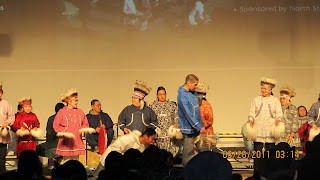We went to the Cama’i (said chuh maya) Eskimo dancing festival. It’s an annual event where each Eskimo village sends a “team” of representatives to the festial to show their particular villages’ dances and songs. They also had some children from the grade school showing their singing and dancing which was very cute!
These boards were up on the sides of the high school.
The event was in the high school, so in the lobby area, there were about 50 people who had tables set up with different craft items for sale. There were piles of fur, ivory carvings, fur hats and baby booties, fur adult booties, dolls made of fish skin (you can see the fish scales in the picture), small dolls, jewelry, hair accessories and so much more! All of the Eskimos who were selling their crafts were very friendly and helpful. I really enjoyed interacting with them.
I asked the woman in the picture if I could take a picture of her with the slippers I wanted to buy for Jeff. When I lifted the camera, her face straightened out so there wasn’t any smile. Instinctively, I said “smile” so she did, but it seems that they tend to put on a very straight face for pictures. Most of the pictures I have seen have no one smiling.
I asked the woman in the picture if I could take a picture of her with the slippers I wanted to buy for Jeff. When I lifted the camera, her face straightened out so there wasn’t any smile. Instinctively, I said “smile” so she did, but it seems that they tend to put on a very straight face for pictures. Most of the pictures I have seen have no one smiling.
We wanted to buy a couple of gifts for family members, but when we found out the prices of everything, we discovered we wouldn’t have near enough money! Nearly everything is handmade and priced to match! The pair of fur slippers in the picture cost $65. A very small ivory carving of a bear was $175. A hair clip was $35. Nothing was cheap, so we left there with only 2 books.
After checking out the crafts, we headed down the hall to a classroom where a group of dancers, called the Tsimshian dancers, from one clan (or village) were doing a couple of songs and dances and explaining their history and describing the symbolism of their clothing.
Because of its availability, cedar played a large part of the native Eskimos lives. It was flexible and able to bend with steam, and was used to make longhouses, clothing, headdresses, hats, bowls, rose decorations. So many things were woven with cedar. For decoration and buttons, they used abalone shells, mother of pearl and glass beads.
Before western contact, the native men wore cedar pants and women wore cedar skirts or nothing. When missionaries came, they thought the nudity was inappropriate and gave the natives wool fabric to make clothing with, but the Eskimos instead made cape-like wraps to go around their shoulders.
The natives have no word for “welcome”. When they are welcoming a person to their village they say “The Fire is Burning for you” (in Eskimo, of course). This is their way of saying the same as “warm your hands on the fire”. A fire is a comfort and a precursor to eating.
In the pictures, you can see that each dancer is wearing a different colored and/or decorated robe. Each robe is symbolic to each wearer. For example; The black borders symbolize a memorial robe, typically received as a gift in memorial of someone who died. The red border symbolizes a life robe, often made by a family member and decorated many family members specifically for one person, and the white border symbolizes purity
The copper color on the robes symbolize poorness in money, but richness in family. The Raven and eagle back to back symbolizes how the village people all work together.
The clan also had 4 clan masks. The Raven, the Eagle, the Killer whale and the Wolf.
One of these robes was given to a woman’s granddaughter. The grandmother was involved in the civil rights of the native Eskimos. The white people put up signs that said where the natives couldn’t sit, etc. The grandmother who passed along the robe was one of two women who sat on benches that had signs that said no Eskimos allowed here. When a man and woman approached them telling them they couldn’t sit there, the Eskimo women said “Harry, Sue, we go to church together. You are no better and no worse or different than I, and I will sit here”. She apparently intimidated them enough that the white people took down the signs.

We weren’t able to go to the dinner where they would serve native Eskimo foods. The Eskimos have high respect for all of their elders and you can see it everywhere, but it was especially obvious at the festival. The entry for everyone was $10 except for the elders where they had to pay $1. As for the dinner, they serve the elders first, for 2 hours. Then after they’re finished, everyone else can come in. We decided not to wait around and grabbed a bite of their fry bread to try (it was delicious) and finished for the day.
This picture is of one of the villages doing their dances and music.

























